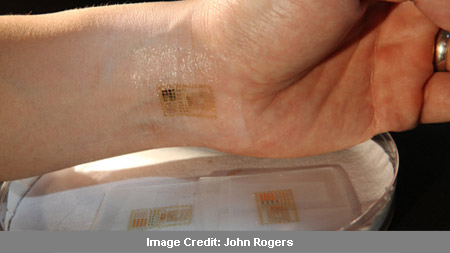
Those having a fantasy of sporting a tattoo can opt for this unique one having biomedical attributes. Well, scientists from University of Illinois seem to have created a device platform which is a combo of electronic components for sensing, medical diagnostics, communications and human-machine interfaces, all placed on an ultrathin skin-like patch. It is touted to be pasted onto the skin and offers the flexibility and convenience of using the tattoo temporarily.
Just like a layer of skin, the piece provides stretching, bending and wrinkling properties. To demonstrate the idea, the analysts used a wide range of electronic components crafted on a sleek and rubbery substrate. It is inclusive of sensors, LEDs, transistors, radio frequency capacitors, wireless antennas, conductive coils and solar cells for power.
“We threw everything in our bag of tricks onto that platform, and then added a few other new ideas on top of those, to show that we could make it work,” explained John A. Rogers, the Lee J. Flory-Founder professor of engineering at the University of Illinois.
These slides are fixed on a thin plate of water soluble plastic and then laminated onto the skin with water similar to a temporary tattoo. Alternatively, the electronic components can also be transfixed directly onto the latter, in a way that conceals the electrical appliances. More recently, skin-mounted electronics have been known to have many biomedical applications such as EEG and EMG sensors to keep the muscle and nerve activities in check. Another apparent advantage is that it does not necessitate a conductive gel, tape, or other skin invasive techniques that are cumbersome for the wearer and also restrict coupling efficacy. They require less space and enable free locomotion to users.
Accessing devices that are not visible to the user seems to be an effective way to gauge neural signals in natural surroundings instead of a laboratory. This helps individuals to a keep a continuous tab on their health, cognitive actions, and behavioral sequences while sleeping. As per the scientists, the tattoo can apparently be put to use for detecting movement of simple speech, human-compute interfacing and be of help to patients of neurological conditions. This kind of an invention requires a new fabrication paradigm as revealed by the investigators. They used a mechanism called filamentary serpentine where the various circuits are fabricated in the form of minute twirled wires. This property enables bending, twisting, scrunching and stretching when they are planted on thin rubbery sheets and sustains their essential functionalities.
This innovative piece incorporates 2 different worlds of electronics and biology under one roof. The Rogers group is now working towards commercializing specific versions of the technology. They are also trying to integrate all devices on the platform and add Wi-Fi features too.
The findings are reported in the August 12 issue of the journal Science.
